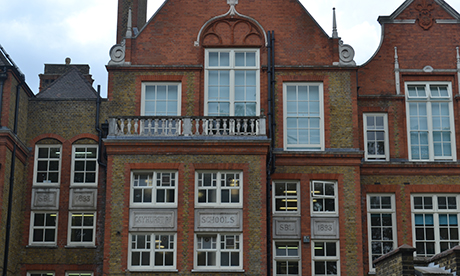Uniform policies spark colourful debate in Hackney Schools

The debate continues over the new uniform being introduced at Gayhurst Community School Photograph: Emmanuel Mair
Over 90 per cent of the borough’s primary schools have a uniform policy in place, and several schools are changing theirs or at least considering doing so.
Berger Primary School is currently changing its uniform while the William Patten Primary School recently audited parents’ views before deciding not to introduce one at all.
Last week, a move by Gayhurst Community School to introduce uniform in September was met with a petition opposing it signed by over 200 people.
While some parents were dissatisfied with the school’s consultation process, the proposal for a “dull” grey and black palette received mixed reviews from some quarters, with the name “Greyhurst” suggested by some nay-sayers.
Parent Lara Bowen, who helped start the Gayhurst petition, said: “I genuinely can’t understand why the school would want to crush and marginalise all creativity and ‘colour’ that East London is thriving on right now.
“I spent last night imagining next winter when Gayhurst children in their grey and black uniforms are filing into the grey and cream Victorian building.
“How is this an inspiring, vibrant learning environment?”
The idea of Hackney as a melting pot of different communities and a hub of creativity has become part of the school uniform debate.
For many parents, the lack of regulation over school clothing allows a child a better mindset in which to express his or herself.
St John of Jerusalem Church of England Primary School near London Fields has other ideas: “We expect all children to wear school uniform into school, as we believe this shared identity gives children a sense of belonging and helps them to take pride in the school and their appearance.”
Meanwhile, both Grazebrook Primary School and Nursery and Shacklewell Primary School state similar principles behind their belief in school uniform as a good thing, “It promotes a sense of pride in the school, engenders a feeling of belonging and identifies the children with the school.”
The schools also claim: “It makes children feel equal to one another in terms of appearance and reflects the sense both of community and of diversity that the school takes pride in.”
So rather than hampering creativity, uniforms actually bring children together and help them to bond under a collective banner, reducing external differences.
However young people, just like everyone else, often have a way of being brutally tactless.
One parent at Gayhurst who wanted to remain anonymous told the Hackney Citizen that her nine year-old son had suffered bullying for ten months over uniform-related issues.
“I’m happy a uniform is coming in,” she said, explaining that her son had been bullied for wearing a particular brand of shoes to school.
“Sometimes he’s scared of going to school. Not everyone can afford designer clothes – if all the kids are wearing the same clothes, they won’t be able to pick on each other.”
Berger Primary School’s change of uniform was “to make them cheaper for parents” according to School Business Manager, Melanie Rennie.
However, fellow parent at Gayhurst, Chris Quayle disagrees that uniform prevents the likelihood of bullying: “Kids are just kids. If they want to, they’ll be able to find other reasons to bully. It’ll just be that instead of different clothing, the kids with the fewest sets of clothes get bullied.
“It may be that the child whose clothes are washed least often gets bullied. Gayhurst reflects a huge range of backgrounds and as far as I can see, people are getting along fine.”
Whether uniform is beneficial or harmful to children’s learning environment, seems to rest largely on the ideological convictions of those teachers and parents of a particular school.
Given that nearly all Gayhurst parents who spoke to the Hackney Citizen, including those against the introduction of a uniform, praised the school for its all-round teaching and ethos, perhaps the biggest challenge for schools will be to communicate effectively with parents in advance so that their uniform policy addresses their concerns.

For both sides…. Read Lois Lawry’s novel The Giver… A world where colour along with many other things has been removed. Novels often reflect what could happen in our future, this novel is a good example of why we should get rid of uniforms altogether.
I really don’t think using Grazebrook as an example of anything is a good idea.
We’ve had a terrible time with the ‘management’ in that school. Teaching is weak and what our child learns is next to nothing. We have had to teach basic geography and capital cities ourselves to our child. the basic geography they do in that school is non-existent but they almost seem proud of that saying it is a creative approach…. well it might be but it results in zero knowledge. The Executive Headteacher does not reply to requests to explain her creative approach and is never in the school when you want her. The other one can not answer basic questions.
Some of these head teachers are so patronising. We had to move our child because the head insisted the work she was doing was appropriate. But shw would not let us take our child’s books out of school. Because I would have taken them to the Department for education and ofsted. It was one of the schools mentioned here.
seeing the media marketing and arts bohomeians and their precious offspring being paraded in and out of Gayhurst like a mini fashion show i can only see this as a good thing
Is there any educational value to having a school uniform? No.